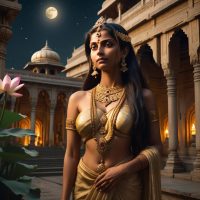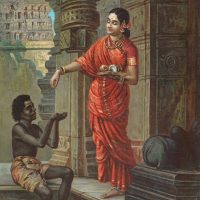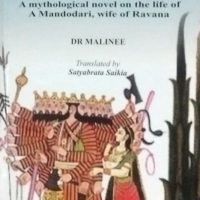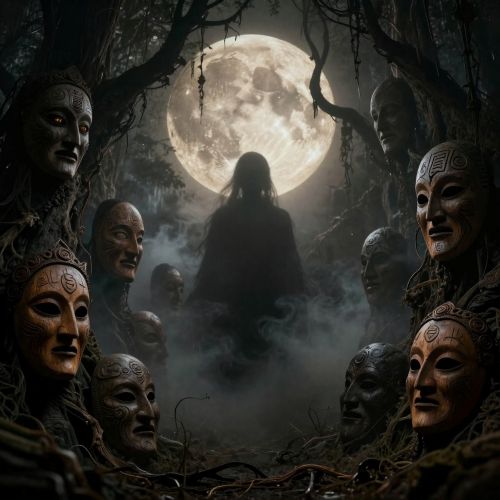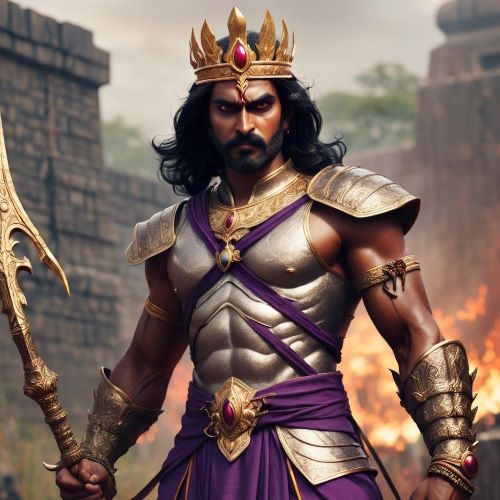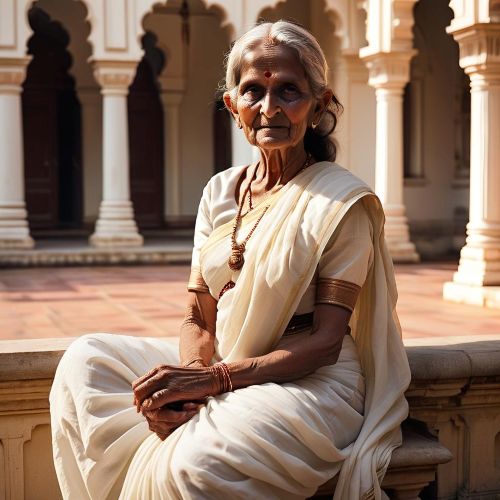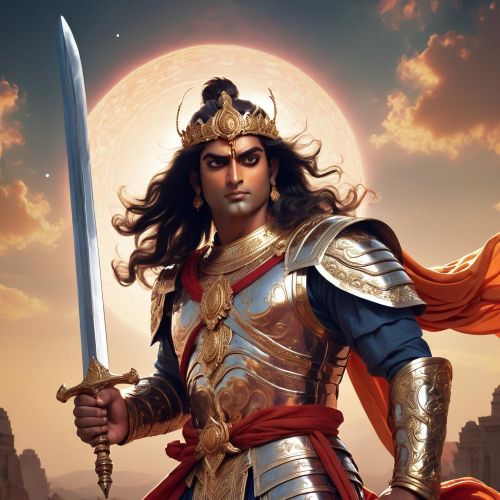Mandodari : The Wise Queen
Listen
At a glance
| Description | |
|---|---|
| Origin | South Asian Mythology |
| Classification | Mortals |
| Family Members | Mayasura (Father), Hema (Mother), Meghanada (Indrajit), Atikaya, and Akshayakumara (Sons) |
| Region | India, Sri Lanka |
| Associated With | Royalty |
Mandodari
Introduction
Mandodari, the queen of Lanka and consort of the mighty Ravana, is one of the most dignified and morally complex figures in Hindu mythology. Featured prominently in the Ramayana, she represents intelligence, devotion, and compassion amidst the turmoil of war and ambition. Her story, though often overshadowed by Ravana’s grandeur or Sita’s virtue, is a testament to moral courage and emotional strength. In both Indian and Sri Lankan traditions, Mandodari’s legacy endures as a woman who upheld righteousness even while bound by her loyalty to a flawed husband. Revered as one of the Panchakanya—five sacred women whose names are believed to cleanse one’s sins—Mandodari continues to embody the timeless ideals of integrity and spiritual wisdom.
Physical Traits
Ancient texts and later retellings describe Mandodari as a woman of extraordinary beauty, grace, and serenity. Her name, derived from Sanskrit, suggests delicacy and refinement—“Mand” meaning calm or soft and “Udara” meaning belly, symbolizing her gentle yet powerful nature. When Hanuman entered Ravana’s chambers in search of Sita, he was momentarily captivated by Mandodari’s radiance and mistaken her for Sita herself. This moment in Valmiki’s Ramayana underlines not only her physical allure but also her aura of purity and composure. Artistic depictions, from classical paintings to temple sculptures, often portray her with regal poise, dressed in the finery of a queen yet exuding an expression of introspective sorrow. Her beauty was said to rival that of celestial beings, but it was her dignity and restraint that truly defined her presence.
Family
Mandodari was born to Mayasura, the master architect of the Asuras, and Hema, a celestial apsara known for her elegance and virtue. This unique parentage placed Mandodari between two worlds—the celestial and the infernal—endowing her with both divine grace and the resilience of the Asuras. According to certain Puranic legends, Mandodari’s origins trace back to an apsara named Madhura, who was cursed by Parvati to live as a frog. Freed from the curse by Lord Shiva, she was reborn as Mandodari, destined to play a crucial role in the Ramayana’s moral narrative.
She married Ravana, the ten-headed ruler of Lanka, who was both a devout follower of Shiva and a symbol of arrogance. Together, they had three sons—Meghanada (also known as Indrajit), Atikaya, and Akshayakumara. Each of them inherited aspects of their father’s strength and valor, and their deaths in battle deepened Mandodari’s sorrow and resolve. After Ravana’s fall at the hands of Lord Rama, Mandodari’s story did not end in despair. Some versions of the Ramayana and later folklore mention that she married Vibhishana, Ravana’s righteous brother, to ensure stability and moral order in the kingdom of Lanka.
Other names
Mandodari is referred to by several names and variations across different texts and regional traditions. Alternate spellings such as Mandodhari or Mandodaree appear in various manuscripts, while some Tamil and Sinhalese retellings refer to her as Maya Sundari, acknowledging her lineage as Mayasura’s daughter. In devotional and philosophical literature, she is honored as one of the Panchakanya—Ahalya, Draupadi, Kunti, Tara, and Mandodari—whose remembrance is believed to absolve sins and inspire purity. The inclusion of Mandodari in this sacred group highlights her unyielding virtue and her capacity to maintain moral clarity even amidst chaos. Her name, often invoked in prayers and verses, symbolizes restraint, dignity, and unwavering righteousness.
Powers and Abilities
Unlike many figures in mythology endowed with supernatural might, Mandodari’s power lay in her intellect, moral conviction, and foresight. She was deeply learned, possessing knowledge of philosophy, statecraft, and spiritual principles. As queen of Lanka, she often served as Ravana’s voice of reason, urging him to return Sita and avoid the calamity that would arise from defying dharma. Despite her husband’s immense power and pride, she never hesitated to counsel him toward righteousness, demonstrating moral courage that transcended fear or attachment.
Her influence, though subtle, permeated the palace of Lanka. She showed compassion even toward Sita, the woman wrongfully held captive by her husband, and grieved deeply for the innocent lives lost in Ravana’s pursuit of victory. Some later texts attribute mystical knowledge to Mandodari, suggesting that she inherited her father’s alchemical secrets and was once entrusted with the preparation of amrita, the elixir of immortality. Symbolically, her wisdom and restraint embody the divine feminine energy (Shakti)—not through aggression, but through the moral strength to confront darkness with grace and clarity.
Modern Day Influence
In modern interpretations, Mandodari has evolved into a symbol of female resilience, moral insight, and silent defiance. Contemporary writers and artists have revisited her story to highlight her emotional depth and ethical fortitude. Indian novelists such as Manini J. Anandani and Varsha Adalja have reimagined Mandodari’s voice, presenting her as a woman torn between love and conscience, yet unwavering in her integrity. These retellings challenge earlier depictions that relegated her to the background, instead portraying her as a moral compass guiding the fate of Lanka.
In Sri Lanka, Mandodari’s legacy takes on additional cultural significance. She is remembered not only as Ravana’s queen but as a symbol of reconciliation and wisdom amid loss. Her portrayal in local folklore, classical dance dramas, and temple rituals embodies both grief and dignity, representing the endurance of virtue even in times of destruction.
In visual media and popular culture, Mandodari’s character has found renewed life through television series, films, and stage performances. She is often depicted as a tragic heroine—a woman of great beauty and intellect whose voice was drowned by Ravana’s pride. Yet, her quiet strength and adherence to truth have made her a timeless emblem of righteous womanhood.
Today, Mandodari’s influence extends beyond mythology into spiritual and social discourse. She is invoked in feminist readings of epics as a figure who demonstrates agency within constraint, and as an archetype of moral steadfastness in the face of overwhelming power. Her name continues to be recited in devotional practices, preserving her association with purity and wisdom.
Related Images
Source
Vedantu. (2025, August 25). Mandodari Stories with Moral in English. Vedantu. https://www.vedantu.com/stories/mandodari
Shukla, M. S. (2021). Indian Tradition and Character of Mandodari: An Analysis. Knowledge Resonance Journal. http://knowledgeresonance.com/wp-content/uploads/2021/08/SP3-1-79.pdf
Williams, G. M. (2008). Handbook of Hindu Mythology. Oxford University Press.
The Sun Lanka. (2025, August 14). Mandodari the Forgotten Queen of Lanka. The Sun.
Sahaja Yoga Bengal. (2025, August 29). Mandodari – The MahaKali Aspect of the Treta Yuga. https://www.sahajayogabengal.com/mandodari-the-mahakali-aspect-of-the-treta-yuga
Matheikal. (2025, April 14). Mandodari: An Unsung Heroine. https://matheikal.blogspot.com/2025/04/mandodari-unsung-heroine.html
Wisdom Library. (2025, September 27). Mandodari: Significance and Symbolism. https://www.wisdomlib.org/concept/mandodari
Valmiki, M. (trans. Griffith, R.T.H.) (1987). The Ramayana of Valmiki. Motilal Banarsidass Publishers.
Goldman, R. P., & Goldman, S. J. (1996). The Ramayana of Valmiki: An Epic of Ancient India, Volume IV: Kishkindha. Princeton University Press.
Doniger, W. (2009). The Hindus: An Alternative History. Penguin Books.
Richman, P. (Ed.). (1991). Many Ramayanas: The Diversity of a Narrative Tradition in South Asia. University of California Press.
Shulman, D. (2001). The King and the Clown in South Indian Myth and Poetry. Princeton University Press.
Lutgendorf, P. (2007). The Life of a Text: Performing the Ramayana in North India. University of California Press.
Frequently Asked Questions
What is lorem Ipsum?
I am text block. Click edit button to change this text. Lorem ipsum dolor sit amet, consectetur adipiscing elit. Ut elit tellus, luctus nec ullamcorper mattis, pulvinar dapibus leo.
What is lorem Ipsum?
I am text block. Click edit button to change this text. Lorem ipsum dolor sit amet, consectetur adipiscing elit. Ut elit tellus, luctus nec ullamcorper mattis, pulvinar dapibus leo.
What is lorem Ipsum?
I am text block. Click edit button to change this text. Lorem ipsum dolor sit amet, consectetur adipiscing elit. Ut elit tellus, luctus nec ullamcorper mattis, pulvinar dapibus leo.
What is lorem Ipsum?
I am text block. Click edit button to change this text. Lorem ipsum dolor sit amet, consectetur adipiscing elit. Ut elit tellus, luctus nec ullamcorper mattis, pulvinar dapibus leo.
What is lorem Ipsum?
I am text block. Click edit button to change this text. Lorem ipsum dolor sit amet, consectetur adipiscing elit. Ut elit tellus, luctus nec ullamcorper mattis, pulvinar dapibus leo.


